By Dan Frasier
How to locate carp on new water, that are accessible to a flyrodder.
I’ve been banging around ideas in my head for how to write a piece describing the best way to locate carp. Frankly, I’ve been struggling a little bit. The problem is, I can look at a satellite map, or walk up to a body of water and have a pretty good idea of what looks carpy. I just don’t know how I know. Then I got a phone call from McTage Tanner last Tuesday.
“Let’s explore Lake McConaughy. I think it could become an A level destination for carp fishing.”
We’d discussed McConaughy before. This massive reservoir lies in the heart of the Nebraska Sandhills where the damming of the North Platte River created a 120-foot deep, 20,000-acre monster lake. Once the home of stripers and still a trophy walleye and trout destination, this behemoth, bottom release reservoir is massively productive; growing trout in its tailwaters at the rate of an inch a month. Ten-pound trout are caught there frequently but it wasn’t the trout we cared about. We did like the idea of clean, highly productive water, situated on a sand bottom holding healthy populations of carp. This could, indeed, be a special place.
Late night phone calls ensued, studying Google maps and soon we’d added two more PhD level carpers to the expedition. We poured through 8-year-old forum reports of carp as by-catch. Looked at bow-fishing sites and records and got anecdotal evidence from some local walleye guys. They don’t fish for carp, but they’d seen ‘em. By the time we left we knew this much, carp lived there and it was huge. Saddle up boys, this could be epic or disastrous, but it probably won’t fall in between.
I met Larry Dostal at his house in Omaha, threw my camping gear into his pickup and we were just getting on toward Lincoln when it occurred to me. For the next day and a half, I was about to do exactly what people asking me, where to find carp, are trying to do. I’m going to a new water body and searching for fish that may or may not be there.
If I paid attention, I’d find all the answers I needed for my piece. So I paid attention.
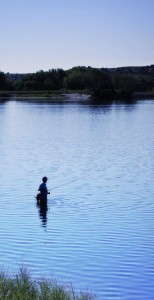 Saturday morning we were on the water. Our first stop would be the dam on Ogallala Lake. This is the lake created by the digging of earth for the dam that built Lake McConaughy. In the construction of this massive earthen dam, the Corp decided to take the dirt from immediately below the dam. This, in effect, created a smaller, cold-water lake at the outlet of the dam, below the major reservoir.
Saturday morning we were on the water. Our first stop would be the dam on Ogallala Lake. This is the lake created by the digging of earth for the dam that built Lake McConaughy. In the construction of this massive earthen dam, the Corp decided to take the dirt from immediately below the dam. This, in effect, created a smaller, cold-water lake at the outlet of the dam, below the major reservoir.
To preserve this lake, the Corp built a number of small spillways that would hold the water back at a certain level before it overflows into a few canals that merge to form the coldwater river that is the South Platte in Nebraska. The entire intricate system creates every type of water an angler could hope for. There is a huge deep reservoir chocked full of life, below that there is a small cold water lake. It’s clear as glass, has flats and currents and supports what amounts to tailwater lake grown Rainbows, and then a true tailwater river. Quite a feat of creation, this dam.
We started at the spillway of Ogallala for two reasons that I think can help any angler begin to identify where to look for carp on new water. The one thing that is absolutely necessary to catch carp with any frequency is being able to get a visual on the fish. If you can’t see ‘em, you can’t catch ‘em. That’s about the sum total of it. Two variables which help to see fish are elevation, and water clarity. We were very certain we’d have both here.
Elevation gives the angler a great advantage in their ability to spot and track fish. Being high above the water allows you to see into greater depths, without having to look through nearly as much water. The lower the angle, the more water you have to see through to see the bottom. This is why flats boats have casting platforms.
The unfortunate thing about elevation is that it is a terrible angle to fish from. Fish’s eyesight is designed to protect them from danger from above. It is far easier for the fish to see you when you are above them, rather than when you are level with the water.
Getting a hookset on a carp from an elevated angle is freaking HARD.
I really haven’t worked out the physics on why this is, but I know that my hookup per eat ratio is 1/10th what it is when I’m lower. So, elevation is good for finding fish, not fishing to them. When you want to search water quickly, get high until you see them, and then get down and figure out how to address them.
The elevation of the dam let us identify a likely little flat that McTage and I waded. We blew 4 fish out of the reeds that we didn’t see and damn near stepped on a big snapping turtle. This place looked perfect and certainly deserves to be re-explored at a different time of day, but our time was limited so we moved on to the small dam on Lake Ogallala proper. The attraction of this spot was the same as the last. The lake boasts painfully clear water over enormous sand flats.
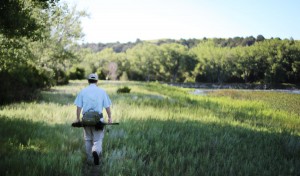 Another key consideration in finding addressable carp is wadability. Most of the time you are going to want to get in the water and stalk to fish, once you’ve found them. Which is how we selected this second spot. Not only did we have some elevation and good visibility to locate carp, but the bottom of the lake is sand and the long flat is only about knee deep. We had a lane we could walk that gave us a 20 foot elevation advantage and let us see for hundreds of yards into the clear water. This lane ran parallel to the enormous sand flat. So we could quickly locate carp, and then easily wade into the water to address them if we found them.
Another key consideration in finding addressable carp is wadability. Most of the time you are going to want to get in the water and stalk to fish, once you’ve found them. Which is how we selected this second spot. Not only did we have some elevation and good visibility to locate carp, but the bottom of the lake is sand and the long flat is only about knee deep. We had a lane we could walk that gave us a 20 foot elevation advantage and let us see for hundreds of yards into the clear water. This lane ran parallel to the enormous sand flat. So we could quickly locate carp, and then easily wade into the water to address them if we found them.
We came up empty, so we decided it was time to fish the massive reservoir of Lake McConaughy. At this point we knew we would be giving up some water clarity and elevation, but by heading up to where the North Platte starts to spread and widen into the reservoir, we thought we could maintain wadability and add another important factor. Warmer water.
Carp feed year round.
While their metabolism does slow, I have fished to them tailing along the side of an ice shelf in December in South Dakota. It’s not the absolute water temp that turns them on. It’s the relative temperature. Uniform water temps let the carp spread out or stay deeper where you can’t get at them with your fly rod. Water that is slightly warmer than the surrounding areas will attract feeding carp. This is why they are so prevalent in the shallows. This led us to the mouth of the reservoir. The large flats created as the North Platte spreads out should warm faster in the sun than the deep water nearby and attract the fish. At least that was the theory.
We pulled into a turnoff and looked at the satellite image on our phones. From here we knew the direction of the water, and the image told us it was close, but we couldn’t see it at all. McTage took a walk to see how far the water was. It was a mile bushwhack to the water and half of it was through a swamp. So this spot was a bust.
 We pulled out the map and decided on a little cove called Omaha Beach. Two factors led to this decision. We knew we may be giving up even more visibility and possibly totally sacrificing wadability. We also knew that we may not be going to a place that was shallow enough to be warmed much by the sun. But it did have one thing going for it. This bay had the wind, which had really started to blow, gusting directly into the bay.
We pulled out the map and decided on a little cove called Omaha Beach. Two factors led to this decision. We knew we may be giving up even more visibility and possibly totally sacrificing wadability. We also knew that we may not be going to a place that was shallow enough to be warmed much by the sun. But it did have one thing going for it. This bay had the wind, which had really started to blow, gusting directly into the bay.
Wind is sort of a next level consideration when looking for carp.
In some places it’s critical and in others it may or may not be important. On huge deep bodies of water wind can be THE deciding factor in finding shallow water carp. In this case it wasn’t really the wind creating the optimal scenario. It was water temperature. On a large water body, wind will push the top layer of warmed water around. If the wind is blowing into a bay, that warm water becomes concentrated and forces the cooler water out deep. The effect is that a stiff breeze on a big water body can cause certain bays to be up to 10 degrees warmer than the surrounding water. It’s a noticeable difference on your legs and the carp will respond.
On smaller water bodies the wind may still play a role. Wind will push all sorts of surface debris to one side of the lake or stream. When concentrations of debris are high enough, carp will often surface feed, or cloop as it’s known, in the areas of concentration. Even when they don’t cloop, the pounding wave action can dislodge all kinds of carp snacks from the bottom and induce big groups of carp to tail in the shallows. While visibility is compromised in these situations, shallow tailing can make for viable targets. And if the carp are feeding on the surface, well then who cares about visibility.
Omaha beach held exactly what we’d hoped for. Possibly 1000 carp feeding on the surface, along the entire length of the bay.
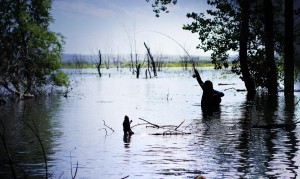 The water was ridiculously murky and had tons of blow downs and deadfalls from the flooded forest. It made wading unbelievably difficult. Every step was over, through or into sunken logs, floating trees or drifting mats of wood. A hooked fish could not be allowed to run an inch or you’d break it off in timber or end up hand lining the fish out of a tree stump.
The water was ridiculously murky and had tons of blow downs and deadfalls from the flooded forest. It made wading unbelievably difficult. Every step was over, through or into sunken logs, floating trees or drifting mats of wood. A hooked fish could not be allowed to run an inch or you’d break it off in timber or end up hand lining the fish out of a tree stump.
We shattered one rod and broke off numerous fish. Hooks were straightened, shins bled and my pants completely filled up with those little green floaty things. But 33 carp were landed in 4 hours. At one point I saw McTage, wading up to his neck and dapping a fly into a pod of 30 rising fish. He hooked up and laughed manically, which was the most fitting end I could think of to the ridiculous trip.
5 Tips for locating carp on new water
Use all of the information available: fishing forums, bow-fishing sites, local anglers and, of course, Google Maps.
Visibility is key. Look for areas with clear water and elevation
Wadability is always a plus. Look for shallow water with hard bottom.
Relative temperature. Look for spots where the water temperature is higher than surrounding areas.
Wind. Look for places where the wind concentrates warm water or food.
Dan Frasier Gink & Gasoline www.ginkandgasoline.com hookups@ginkandgasoline.com Sign Up For Our Weekly Newsletter!


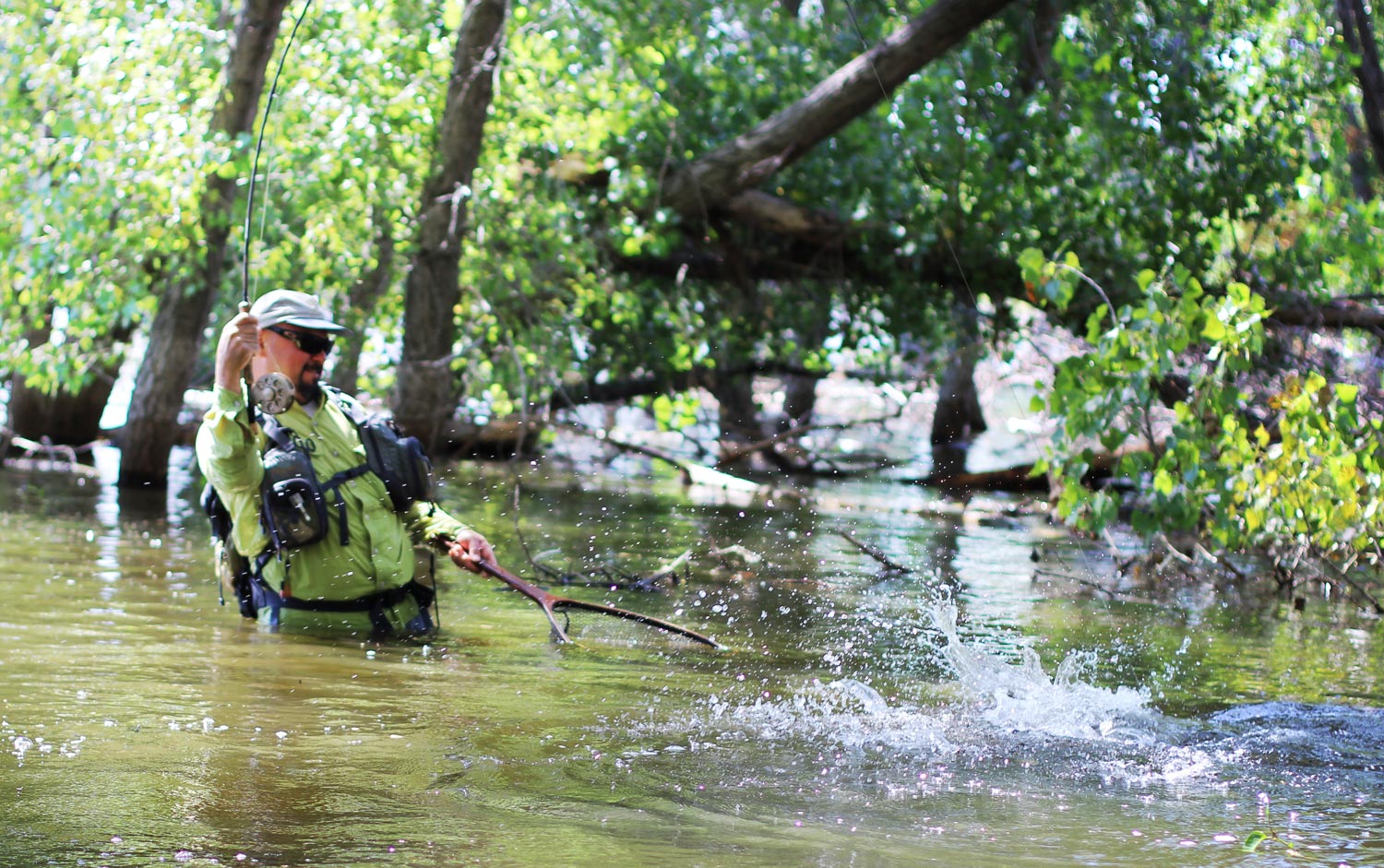
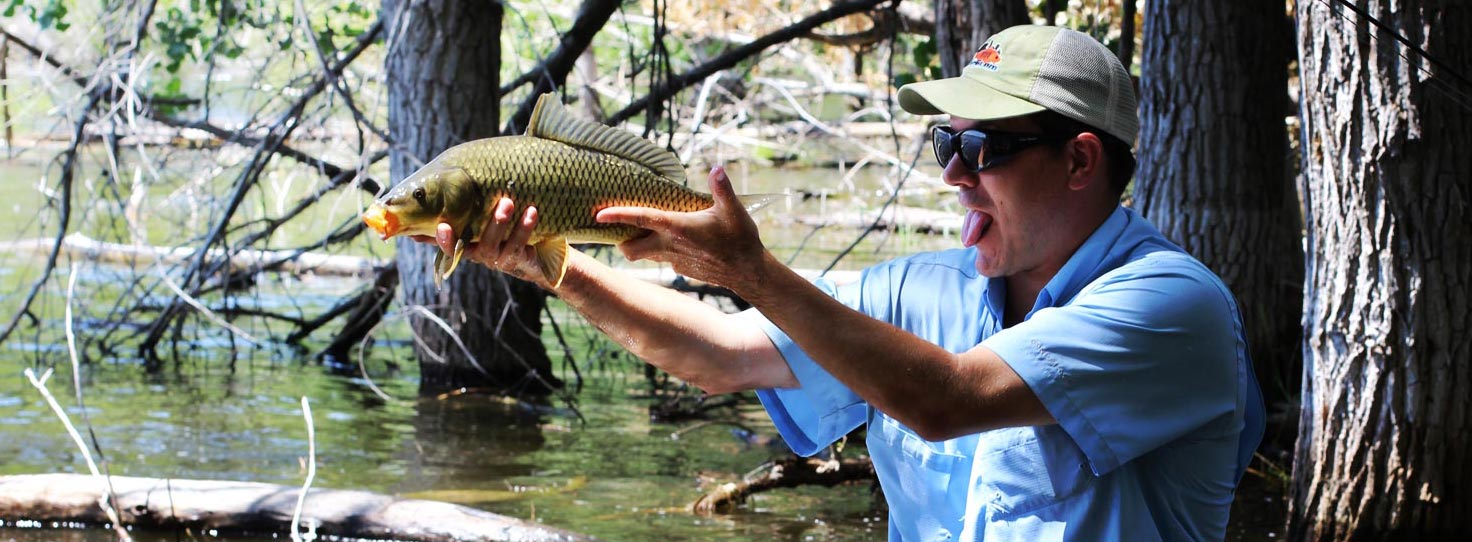
most of the time I explore new water, its a new and unpredictable challenge. take the time to contact your local Division of Wildlife to see if the water is fishable, explore it at different times of the day, different times of the year also.
Why did you leave the first flat where you blew fish out? When I fish new water, I just start at point A (determined by using pre-approach and online research) and wander around until I blow something out. Then I start fishing. Were there other factors that led you to leave that spot right away? Or did you give it more time than the article implies? Thanks for the read.
http://fishingbuddyblog.blogspot.com/2015/07/fishing-buddy-code.html
Great question. This was a small flat with painfully clear water over a sand bottom. We could, literally, see everything that moved on the flat. There was a line of reeds along one edge and as we walked the flat we moved 4 fish, one at a time, out of those reeds. In there they were unfishable and any fish out on the flat proper we would have seen. So we walked the flat until we’d covered it all and then moved on. We would have gone back later in the day to recheck the flat, but there was so much water to cover elsewhere and we were there specifically to scout so we spent the rest of our time looking at other spots. Basically, we noted that when we go back to this place that small flat will have fish somewhere and will get fished again and then moved on.
Good info!
Great article! Water temperature always seems to be one of the biggest factors and more often than not (for large rivers, ponds, and lakes anyway) the wind is the biggest factor on where the warm water (and carp) can be found.
I love google maps… what did we do prior?
cheers,
Brian.. I hear you about Google Maps. I have no idea. Yeah water temp is the most critical factor determining where the fish are feeding. It doesn’t, however, let you know where they will be fishable. So sometimes you have to sacrifice a little. Fish water that may not hold as many feeding fish, but gets you better shots at the ones that are there. Sometimes. When you can find water where the warmest spots are also easily fishable, then you’ve really found something.
thanks, I have wondered about McConaughy and carp.. hoped you’d report fine flats fishing though, that combat-style fishing up in the trees with veins in my teeth, is a bit hardcore for me 😉
To be clear doug, I’m certain the flats fishing there is great. We didn’t happen to find them on the flats, but the flats exists and are wonderful and the fish are there. I think the high water, combined with our limited time hurt us but I have no doubt the flats can be great.
Great write up! Love how carp are moving up in the world!
Mac is so not in the heart of the Nebraska Sandhills that it’s not really in the Sandhills at all.
Pingback: Carping - NEBRASKALand Magazine
I own Dan’s book on Carp flies and how to fish them. Great fun tying the flies and pursuing these elusive fish around Lake Michigan area.